Gloria Reynolds is an aerospace engineer and comic artist living in the Pacific Northwest. Her posthuman science fiction comic Aphelion is something I’ve been longing for for years: a comic that stretches the imagination and shows images that are uncomfortably unfamiliar, but with rigorous, naturalistic thought applied to the setting and events. I put it on a very narrow shelf with PLANETES and, frankly, not much else.
Gloria sat down for a couple of hours with me on Skype and we chatted about engineering, science fiction, and creative process.
Joshua:
I’d like to start by saying that Aphelion is an incredible breath of fresh air, but I can see why there’s not more like it: it’s really dense, training wheel-free, super-hard SF. You don’t get there without a huge commitment. What got you there?
Gloria:

Thank you! Aphelion definitely couldn’t exist as anything other than a passion project. It’s made too slowly and is too confusing to be profitable. It exists because I wanted something like it to exist and I couldn’t expect anyone else to do it.
Joshua:
I think that’s where the best art comes from. Which seems to be a bug in our form of economy.
Gloria:
It is incredibly freeing to have only myself to answer to. And it is pretty sad that it could only exist as a hobby.
Joshua:
It is! What do you to to keep yourself answerable? You took a break for a while, and then came back, which is pretty unusual for passion projects.
Gloria:
Weirdly, the most important thing for me is to never tell anyone it will be done. Maybe I won’t finish Aphelion. That could happen. But for me, knowing that it’s optional is important. The minute I tell myself I must work on it, it’s over, that’ll be the end of it. Aside from that I try to make sure that a lot of the story is still in development. The concept work is the most fun for me, so I make sure there’s plenty left to do.
Joshua:
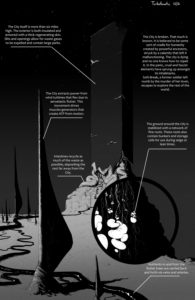 Yes! I’ve discovered the power of Never Promise, as well! The concept art is great stuff. You answer these questions (“What are those big fins sticking out of the ground?”) with these really detailed answers (“Power generators that oscillate.”) that produce more questions (“What’s the network that makes these things work? Is this like mycorrhizae?”), giving everything a sense of complexity that lets us trust that everything, even things we don’t see right now, makes sense.
Yes! I’ve discovered the power of Never Promise, as well! The concept art is great stuff. You answer these questions (“What are those big fins sticking out of the ground?”) with these really detailed answers (“Power generators that oscillate.”) that produce more questions (“What’s the network that makes these things work? Is this like mycorrhizae?”), giving everything a sense of complexity that lets us trust that everything, even things we don’t see right now, makes sense.
How much does your concept drawing affect the practical details of the setting? Or do you plan it, then draw it out?
Gloria:
Usually there’s an idea or a mental image first, biological wind turbines in this case, and then there’s a lot of artwork trying to make it look clear, plausible, and interesting. There’s a lot of refinement that goes on in the drawing stage. Sometimes what I think will look good doesn’t. And usually it’s the design work that the setting is built around. The D-fect story wouldn’t exist without the flutter trees.
Joshua:
Mm, yeah. And that comes from thinking about the broad-ranging effects of the engineering aspects of the technology/ecosystem?
Gloria:
Absolutely! If I want the sort of setting that will give me fields of noisy fluttering trees for my characters to walk through, I need to know why they exist. So maybe they produce power, but if they’re biological, then how do they transmit that power? Via a bloodlike fluid perhaps? So then there’s a network of arteries and veins. And that requires something biological to pump it, so then there’s block sized hearts and etc.
Joshua:
Yeah, right on. The reasoning feels really well-supported to me as an enthusiastic non-engineer.
What’s the process that led to Earth being in this condition? Is it all just a byproduct of Singularity?
Gloria:
In Aphelion, the singularity doesn’t play out like most people theorize. If you could even call what happens in Aphelion a singularity. What happens is that hyperintelligent and hyperempathetic hiveminds are created. And they save the world. At first anyways. People still try for more selfish versions of AI and it backfires. Badly.
Joshua:
Yeah, you’re doing a neat thing here, where the Hive Mind is influenced more by our experience of Google and Twitter than with our fears of the USSR.
Gloria:
It seems like, if it makes sense to model hive minds as a larger version of the human dual-hemispheres then it makes sense to have a diverse range of members with different capabilities, since the left and right hemispheres don’t do the same things.
Joshua:
Sure. A sort of, “Let’s ask #e5ffa732. She knows what to do in this kind of situation, and we’ve only got 13 milliseconds to act.”
Gloria:
Of course, I also like the idea of how embarrassing it must be for most characters to live around something that is so much smarter than you and also wants what is best for you. Having the hives be nice is probably optimistic but that was something fun to explore.
Joshua:
Sure. It leaves us with the same questions that the Minds do in Iain M. Banks’ Culture series: “Why do they put up with slow, petty, high-entropy, 4D-bound humans?”
Gloria:
Yeah! We’re like both pets and potential future components to them!
Joshua:
On the other hand, why not? People who own the least, give the most. When some of those beings have the perspective to know just how little they have in the scope of the universe, they might, indeed, consider helping to be simply the most fun, moral, satisfying thing to do.
Gloria:
Sometimes its nice to help worms off the sidewalk after the rain when you have a lot of free time and energy.
Joshua:
Yeah: the cost of expressing empathy is low. But I think the fact that people with less give more, proportionately. It has to come from a place of understanding need.
Gloria:
That’s also true
Joshua:
I’m interested in your art and science influences. I see some of Giger’s Biomechanics, and some of Barlowe’s naturalism, with his love of veins and folded flesh in your work, and the ideas are obviously in response to Vinge’s (probably naïve) vision of Singularity. So what are you synthesizing, and what are you building from whole cloth? At the heart of Aphelion, what do you consider its core themes, and how are you building toward them?
Gloria:
Thematically, Aphelion is at least partly about dealing with too little or too much information

The aesthetics themselves are kind of an overload, and while you can glean much of the backstory from what’s happening in the background, it takes real work to do that. The plot basically happens when hyperintelligent hives and AIs made mistakes because they couldn’t get all the information they needed. So the reader is kind of in the same situation
Joshua:
Oh, that’s really interesting. It’s one of my favorite themes in high-stakes stories: drastic action taken because of human error. But fallibility is even more terrifying when you ascribe it to entities an order of magnitude (with new orders of magnitude coming at regular intervals) greater than humans at information processing.
Gloria:
Yeah! I fully expect super smart entities could do some impressive stuff, but I think that improved processing power is somewhat overrated
Joshua:
I imagine that’s related to your skepticism about Singularitarianism in general.
Gloria:
Pretty much, the issue with simulations of reality is that in order to improve their accuracy, the power and complexity of the simulation must increase exponentially. One can predict the lift of an airfoil by hand using thin airfoil theory. Going beyond that into stuff like CFD requires much more work for a small increase in accuracy.
Joshua:
So the length of time between exponential increases is increasing?
Gloria:
Or rather, it’s like the 80/20 rule, but worse. You can make a good guess of the outcome of something with only a little intelligence, getting a better guess takes more and more, and perfect simulation is impossible.
Joshua:
That’s a lot of entropy. I suppose that’s the benefit of the “gut reaction”: you stop simulating and take a guess that’s worked well for your ancestors. With all that biotech, I’d expect your AIs to be really into microflora chemical processing for otherwise-shrugworthy situations.
Gloria:
Haha, I think they do rely on intuition a lot, they work hard to be rational but they’re very in tune with their “gut”
Somewhat related, the F-15 eagle was created about the same time after the F4U corsair (a great WWII plane), as the F-22 was after it. And in some ways the F-22 is inferior to the F-15, despite having fancy computers involved in its design.
Joshua:
I’ve always chalked that up to the Corsair being designed to the specs of practical need and experience, while the F-22 was designed to the specification of maximizing the expenditure. And the F-35 is designed to the specification of continuing to produce F-22-like conditions. The simulation (who the hell are these weapons to fight?) outweighed the practically-infinite processing power of the real world.
Gloria:
Even other countries are hitting this issue, and its prevalent in rocketry too. Humans figure out the easy parts in a field like aerospace quickly, then must work harder to get further.
Joshua:
Sure. And we experience that horrible fluctuation as artists, too, right? Your ability to create and your ability to accurately critique your own work are 180° out of phase.
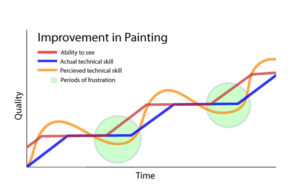
This graph shows how creators are doomed to repeat that cycle forever.
So sometimes you get to the hard part (maximally and painfully correct critique, stagnant skill), and you lose hope. Or, in the case of economies and societies, you starve.
Gloria:
Aha! I like that chart. Pushing past that is difficult. It is true that once you have a breakthrough (in say thermodynamics or figuring out how to draw anatomy) its very easy to capitalize on it, but the rate of improvement diminishes with time, at least until another breakthrough comes along.
Joshua:
And the progress toward that breakthrough seems to be invisible, because what you’re learning, you don’t yet know; it shows itself as introspection at best, criticism and pessimism at worst.
You’re an engineer, right?
Gloria:
Yep! I’m an aerospace engineer
Joshua:
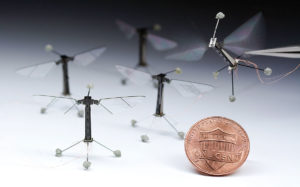
Credit: Kevin Ma and Pakpong Chirarattananon, Harvard Microbotics Lab.
Right on. So, what we’ve learned about low-R aerodynamics in the last decade is incredible. But, like, how do we express that to someone who’s used to jetliners and wants a better flying experience?
How how do we say, “We don’t know the benefit yet, but we can, I mean, in theory, make flying machines like insects or fabricate ornithopters that could fly on Mars, don’t you realize how amazing that is?” when they were promised a Concorde in every terminal and a flying car in every garage.
Gloria:
Well, asking them to think about how bad it would be to give every idiot driver their own airplane might help 😉
Joshua:
Well, at least current models don’t propose to do that.
The Ehang taxi drone seems the most likely route, should the solution ever find the problem it solves.
Gloria:
Yep! Though it’ll be a long time before I trust one enough to get in! Things never seem to turn out like their predictions. Which is something I wanted in Aphelion, not sure if I got there but it was fun! But yeah, passenger drones would have to deal with control issues far beyond driverless cars, plus noise issues, plus less efficiency, etc…
Joshua:
Weirdly, the response seems to be, “But what if the automation fucks up?” To which I respond with a Twitter search of “drone tree“. It’s not the computation making that happen.
Gloria:
Ahahaha, that’s a good search!
Joshua:
I do it annually on the day after Christmas.
Gloria:
I think most people are actually aiming for driveable aircraft now instead of flyable cars
Its not so much a change in technology but a change in thinking about it. Making the customer a certified pilot solves most of the dummyproofing issues
They’re aimed for pilots that can’t or don’t want to leave the plane at the airport, and building it as a decent plane and a bad but workable car
Joshua:
I suppose that’s a market. But the interesting thing to me is that the passenger drone obsolesces the entire mental framework of “the jetpack” or “the flying car”. Because what’s going on is that we understand aerodynamics enough to define the form, just like now we understand computers enough to carry them around with us all the time and get our news from them. Or, perhaps, we understand computers enough that fulfilling all of the promises of AI no longer seems like AI.
Gloria:
Well if you had driverless cars presumably you’d remove most reasons for a jam.
Joshua:
Precisely. Herd movements.
Gloria:
Murmurations of drones…
Joshua:
A Murder of Drones.
So how do you get from this Systems Thinking, engineer stuff to comic artist? Or the other way?
Gloria:
I think, in my mind, they’re not that different. When I was young I designed a lot of silly spaceships and such, and I had to draw them, so I practiced that a lot. The art and science divide always seemed somewhat artificial
Joshua:
Definitely. Artists are always developing, adopting, and interpreting technologies toward their art, and engineers are, to a large extent, in the business of implementing their imagination.
Did you study art formally?
Gloria:
I went to a few summer classes, in grade school but that was about it.
At the end of the day both art and engineering is all about, “I want this thing to exist how do I make this thing exist?”
Joshua:
Definitely.
90% of art is just trying again, and art classes (and school) are a place to generate so much work that the 10% is enough of a body to have an impact.
How much drawing do you do on a day-to-day basis?
Gloria:
I doodle almost every day, and try to work a little on a project each day
Joshua:
I really appreciate that “always make a little” work ethic. It’s really distinct from the “art as product” model that we’re used to in our economy. I suspect it’s part of why Aphelion is so dense, too: you’re putting so much thought into every drawing that it’s worth it for the reader to read it closely.
Gloria:
Honestly I’m not sure I’d have the stamina to work all day on art. I like to take a lot of time to consider things, which is fine for engineering but not so good for getting a product out the door.
I’m prone to analysis paralysis, but I’ve made my peace with that
Joshua:
Well, how much of Aphelion could be in your descriptive concept art? You imply so much story when talking about supersonic birdbots. Is that analysis paralysis, or is it a close zoom to show, rather than tell?
Gloria:
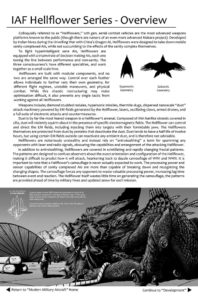
Their camouflage is designed to make their opponents waste processing power by making their exact facing hard to read.
I think the sort of thought style that gets these close zooms (which I love!) is prone to analysis paralysis as a side effect, which is why I’m okay with that. It’s a very acceptable mental hiccup for the sort of thing I want to do.
Joshua:
Your happiness with it generates a pretty good product!
Thanks a ton. I love your work and look forward to seeing what you make in the future, at whatever rate you can make it.
Gloria:
Thank you!
You can find more of Gloria’s work at her Tumblr, Turbofanatic.
This article is part of a series of interviews with concept artists and other vivid imaginers of possible places and times. I’m hoping to continue them in the future, but if you want more before I do, you might want to read my interview with comic artist Simon Roy of Prophet and Habitat, as well.
If you want me to keep going with this, or other, elements of xenoglyph, please subscribe to my Patreon to get all sorts of goodies, like art collections, complete roleplaying games, and special deals on physical copies and T shirts!
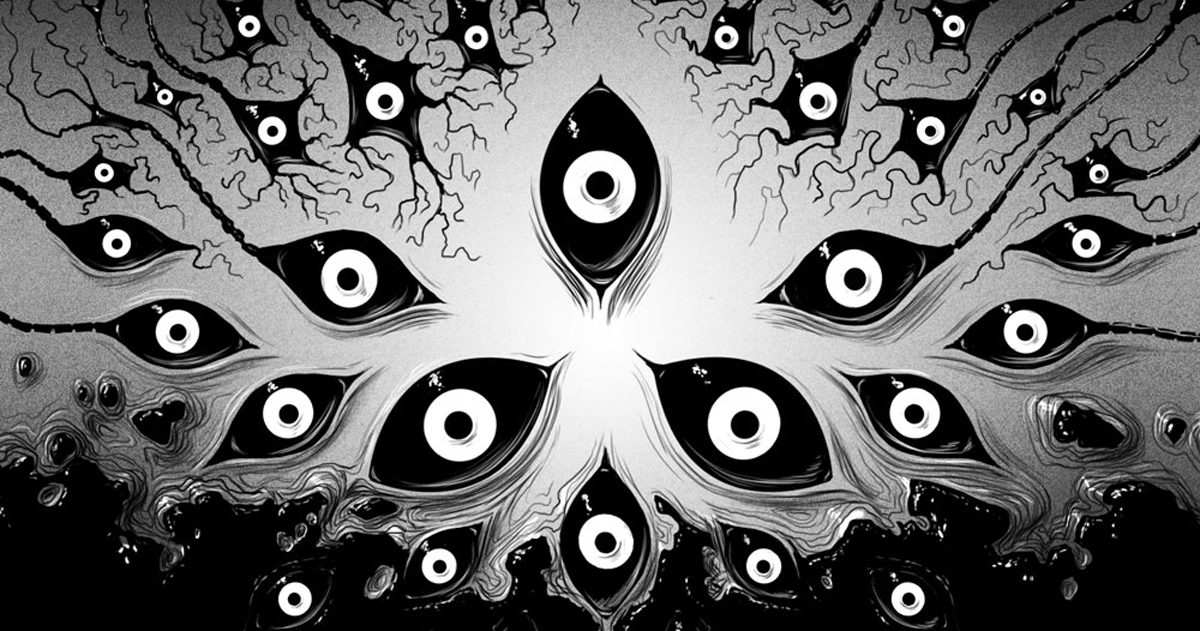

I really enjoyed this interview. It’s given me a lot to think about in terms of my own writing.
Also that Drone tree stuff is really funny!